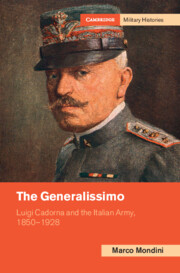Refine search
Actions for selected content:
15401 results in Military history
Chapter 6 - Counterinsurgency
-
- Book:
- Soldiers and Bushmen
- Published online:
- 29 July 2025
- Print publication:
- 06 August 2025, pp 147-172
-
- Chapter
- Export citation
Index
-
- Book:
- Soldiers and Bushmen
- Published online:
- 29 July 2025
- Print publication:
- 06 August 2025, pp 235-243
-
- Chapter
- Export citation
Chapter 8 - Conclusion
-
- Book:
- Soldiers and Bushmen
- Published online:
- 29 July 2025
- Print publication:
- 06 August 2025, pp 198-201
-
- Chapter
- Export citation
Chapter 5 - Combat
-
- Book:
- Soldiers and Bushmen
- Published online:
- 29 July 2025
- Print publication:
- 06 August 2025, pp 120-146
-
- Chapter
- Export citation
Bibliography
-
- Book:
- Soldiers and Bushmen
- Published online:
- 29 July 2025
- Print publication:
- 06 August 2025, pp 227-234
-
- Chapter
- Export citation
Copyright page
-
- Book:
- Soldiers and Bushmen
- Published online:
- 29 July 2025
- Print publication:
- 06 August 2025, pp iv-iv
-
- Chapter
- Export citation
Chapter 2 - The Australian Army in South Africa
-
- Book:
- Soldiers and Bushmen
- Published online:
- 29 July 2025
- Print publication:
- 06 August 2025, pp 35-71
-
- Chapter
- Export citation
Figures and maps
-
- Book:
- Soldiers and Bushmen
- Published online:
- 29 July 2025
- Print publication:
- 06 August 2025, pp viii-x
-
- Chapter
- Export citation
Chapter 1 - Raising Australia’s Army
-
- Book:
- Soldiers and Bushmen
- Published online:
- 29 July 2025
- Print publication:
- 06 August 2025, pp 10-34
-
- Chapter
- Export citation
Chapter 3 - Command
-
- Book:
- Soldiers and Bushmen
- Published online:
- 29 July 2025
- Print publication:
- 06 August 2025, pp 72-96
-
- Chapter
- Export citation
Notes
-
- Book:
- Soldiers and Bushmen
- Published online:
- 29 July 2025
- Print publication:
- 06 August 2025, pp 202-226
-
- Chapter
- Export citation
Preface
-
- Book:
- Soldiers and Bushmen
- Published online:
- 29 July 2025
- Print publication:
- 06 August 2025, pp xi-xii
-
- Chapter
- Export citation
Introduction
-
- Book:
- Soldiers and Bushmen
- Published online:
- 29 July 2025
- Print publication:
- 06 August 2025, pp 1-9
-
- Chapter
- Export citation
Contents
-
- Book:
- Soldiers and Bushmen
- Published online:
- 29 July 2025
- Print publication:
- 06 August 2025, pp vii-vii
-
- Chapter
- Export citation
Chapter 4 - Morale
-
- Book:
- Soldiers and Bushmen
- Published online:
- 29 July 2025
- Print publication:
- 06 August 2025, pp 97-119
-
- Chapter
- Export citation
Chapter 7 - Coercion
-
- Book:
- Soldiers and Bushmen
- Published online:
- 29 July 2025
- Print publication:
- 06 August 2025, pp 173-197
-
- Chapter
- Export citation
Dedication
-
- Book:
- Soldiers and Bushmen
- Published online:
- 29 July 2025
- Print publication:
- 06 August 2025, pp v-vi
-
- Chapter
- Export citation

The Generalissimo
- Luigi Cadorna and the Italian Army, 1850–1928
-
- Published online:
- 31 July 2025
- Print publication:
- 14 August 2025
Copyright page
-
- Book:
- Grains of Conflict
- Published online:
- 23 August 2025
- Print publication:
- 31 July 2025, pp iv-iv
-
- Chapter
- Export citation
Conclusion
-
- Book:
- Grains of Conflict
- Published online:
- 23 August 2025
- Print publication:
- 31 July 2025, pp 225-236
-
- Chapter
- Export citation
